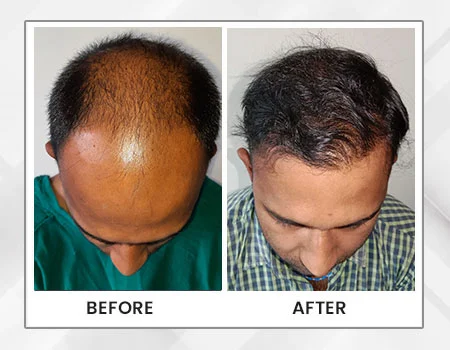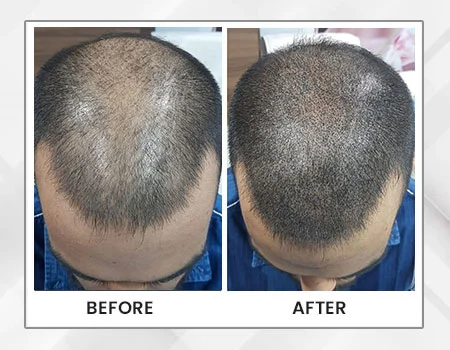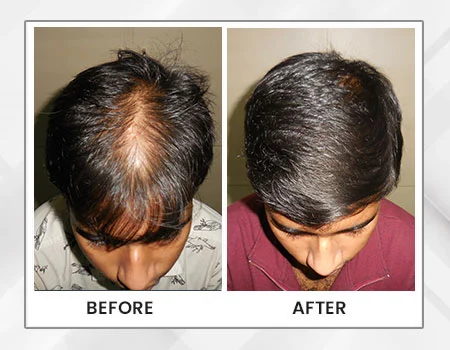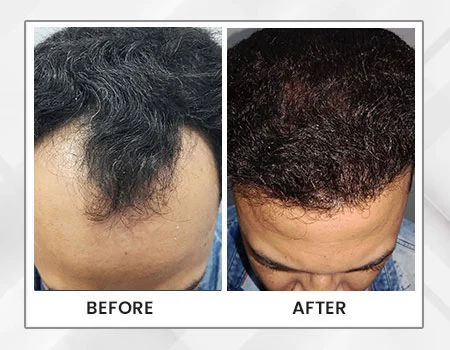Painless Hair Transplant From Dr. Paul’s Advanced Hair and Skin Solutions
Book Appointment
- Local Anesthesia: Before the procedure begins, local anesthesia is administered to numb the scalp. This ensures that the patient doesn’t feel any pain during the extraction and transplantation process. Advanced techniques in administering anesthesia can also minimize discomfort during and after the procedure.
- Gentle Extraction and Implantation: Skilled surgeons use techniques that minimize trauma to the scalp during both the extraction and implantation phases of the procedure. This can reduce post-operative pain and discomfort.
- Advanced Technology: Utilization of advanced tools and technology can contribute to a more comfortable experience for the patient. For instance, robotic-assisted FUE (Robotic Hair Transplantation) can offer precision and reduce the chances of human error, potentially leading to less discomfort.
- Post-Operative Care: Providing proper instructions and medications for post-operative care can help manage any discomfort or pain that may arise after the procedure. This may include pain medications and anti-inflammatory drugs.
- Patient Comfort Measures: Painless Hair Transplant in Siliguri may offer amenities such as comfortable seating, entertainment options, and a relaxing environment to help patients feel more at ease during the procedure.
Hair transplantation typically involves several stages,
Here’s a general overview of the stages involved in a typical hair transplant procedure:
- Consultation and Evaluation: The process begins with a consultation with a qualified hair transplant surgeon. During this appointment, the surgeon will evaluate the patient’s hair loss pattern, assess the quality and density of donor hair, discuss the patient’s goals and expectations, and determine if they are a suitable candidate for hair transplantation.
- Preparation: Before the procedure, the patient may be advised to refrain from certain medications and activities that could interfere with the surgery or recovery process. Pre-operative instructions may also include washing the hair and scalp to minimize the risk of infection.
- Anesthesia: On the day of the procedure, local anesthesia is administered to numb the scalp. This ensures that the patient remains comfortable throughout the surgery.
- Donor Hair Harvesting: Depending on the chosen technique (e.g., FUT or FUE), the surgeon will harvest hair follicles from the donor area of the scalp. In FUT, a strip of hair-bearing skin is removed from the donor area, while in FUE, individual follicular units are extracted using a specialized punch tool.
- Graft Preparation: After harvesting the donor hair, the surgical team carefully dissects the hair follicles under a microscope to create grafts of the desired size and quality. Graft preparation is crucial for ensuring successful transplantation and natural-looking results.
- Recipient Site Creation: Using tiny incisions or recipient sites, the surgeon strategically places the grafts into the recipient area of the scalp, taking into account the patient’s natural hair growth pattern, hairline design, and aesthetic goals.
- Graft Insertion: Once the recipient sites are prepared, the grafts are meticulously inserted into the scalp using forceps or implantation devices. The surgeon pays close attention to the angle, direction, and density of the transplanted hair to achieve a natural appearance.
- Post-Operative Care: After the procedure, the patient receives detailed instructions on how to care for the newly transplanted hair and scalp. This may include information on washing the hair, avoiding certain activities, and taking prescribed medications to aid healing and minimize discomfort.
- Recovery and Follow-Up: In the weeks following the procedure, the transplanted hair sheds temporarily before entering a new growth phase. Patients typically return for follow-up appointments to monitor progress, address any concerns, and receive additional guidance on hair care and maintenance.
- Long-Term Results: Over time, the transplanted hair gradually grows and matures, blending seamlessly with the existing hair. Patients can enjoy natural-looking, permanent results that enhance their appearance and confidence.
Each stage of the hair transplant process is crucial for achieving optimal outcomes, and patients should closely follow their surgeon’s recommendations for the best possible results.
TREATMENT SUMMARY
- Number of Sessions – 1
- 7-8 hours Operation Time
- Permanent Persistence of Results
- No Hospitalization
- 3-15 Days Sensitivity Time
- 3 Days Time to Return to Work
- Sedation and Local Anesthesia
Perennial service
Use Of Dentapen
We can say with conviction that when it comes to DentaPen, there are no two ways that this is the best technology. It is a robotic syringe known to be nothing less than a cutting-edge device. So what is the use of the same? Well, this is a computer-controlled system that ensures that the local anaesthesia delivery system makes injections absolutely pain-free.
The Dentapen offers several advantages over traditional syringe-based anesthesia delivery systems, including reduced pain and anxiety for patient. Not only does it make the process easier, but the pen also has some other implications














